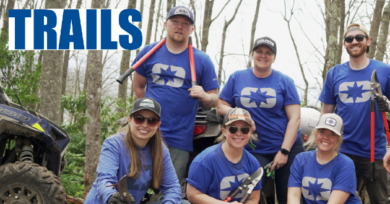July 2, 2007 – Showing off a sporty side
By Tom Kaiser
ATV Editor
Using a name meant to evoke Mother Earth, advanced technology and the mighty T-rex dinosaur, Kawasaki has released a sport recreational vehicle dubbed the Teryx.
Pronounced however you’d like it to sound, according to Kawasaki, the Teryx 750 4×4 casts a similar but wider shadow as the popular Yamaha Rhino and aims to compete in the recreational side of the UTV market.
With competitors like the Rhino, Polaris’ Ranger and RZR and Arctic Cat’s Prowler rapidly becoming crucial products for their respective manufacturers, Kawasaki should have no trouble racking up sales for its first-ever recreational UTV. And, taking further liberties with naming rights, Kawasaki prefers to eschew the term side-by-side, instead preferring to label the Teryx a recreational sport vehicle.
“Side-by-side just doesn’t strike us as making a lot of sense, because we didn’t build an ATV,” said Vince Iorio, Kawasaki’s product manager of the ATV and utility vehicle segment. “I could see something narrower being called side-by-side, but we feel we’ve broken the mold on that class and created something that is really recreation-oriented, sport-oriented.”
At 58.3 inches wide, 3.9 inches more than the Rhino, Kawasaki is quick to say the vehicle is more stable than its competition. At the same time, company officials say it will still fit in the bed of a full-size pickup truck.
A 749cc liquid-cooled four-stroke V-twin engine powers the Teryx. The engine, pre-existing from the company’s Brute Force 750 ATV, is the first V-twin in its class. It’s mated to a belt-driven CVT with high and low ranges, reverse and standard engine braking. It also has selectable four-wheel drive, a variable locking front differential and a sealed rear brake for extended maintenance intervals.
“We feel that we’ve brought a new level of technology, performance and handling to this category,” Iorio said. “It has a proven engine, better suspension, better performance [and] better styling, we feel, than anything currently on the market.”
With gas-charged shocks all around and reservoirs in the rear, Iorio says the Teryx comes with an upgraded suspension on the base model, as opposed to including up-level shocks on the option sheet. The dual A-arm front suspension provides 7.5 inches of travel up front. The independent rear suspension has 7.25 inches of travel. It all adds up to 11.2 inches of ground clearance.
Other features include a steel rear bed, which is rated to haul 500 pounds worth of cargo, enough to haul two field-dressed deer carcasses, according to Iorio; 26-inch Maxxis tires and a mid-ship engine bay for an improved front-to-rear weight bias and cornering control.
Teryxes, or perhaps Teri, come in three different trim levels: standard, LE (luxury edition) and NRA Outdoors. The luxury model includes additional creature comforts like a hardtop, half windshield, digital speedometer and a sliding cup holder in the dash. The NRA model builds on the LE, with the addition of dual gun scabbards and Realtree camouflage plastics, wheels, hardtop and dashboard — the most camo available on anything else on the market, Iorio said.
Pricing for Teryx models was not available at press time, but the vehicle is expected to start hitting sales floors in the coming winter season. From the gate, more than 60 accessories will be available, ranging from body and weather protection, comfort, graphics packages and possibly an upgraded exhaust system.
Recreational Optimism
Iorio said the Teryx will be the first product for a new business unit within the company. When asked about future recreational UTV products, Iorio declined to answer, but said, “We have many more exciting products that we are in active development on.”
He declined to release any sales projections for the Teryx but said the company is optimistic the vehicle will find its place in the market. He also added retail sales of the company’s latest Mule iterations, the 610 and 3010 Tranx4x4, still haven’t reached their peak.
The company also expects the Teryx to be heavily modified and raced, much like the Rhino.
“We didn’t build this as a racing vehicle, by any means, but we are certainly aware of all the modifications and the racing that’s taking place,” Iorio said. “The vehicle’s certainly capable of enduring that … due to the engine.”
the name game
Getting back to that unusual moniker, Iorio said the company first developed the name Teryx in 2002 and held on to it, for its suggestion of terra firma and its similarity to the T-rex name.
“Naming in this day and age is extremely challenging, to say the least,” he said. “We wanted to allow people to embrace it, and we wanted it to be different.”




